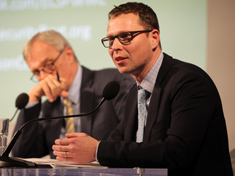-
Richard Choularton on 3 Steps to Avert the Famines We See Coming
February 17, 2017 By Benjamin Dills There has been great progress in anticipating famines in recent years, with most predicted six or more months ahead of time, says Richard Choularton, senior associate for food security and climate change at Tetra Tech, in this week’s podcast. But action to address their humanitarian impacts has lagged. Responses need to be more consistent and faster, he says, happening “almost without human intervention.”
There has been great progress in anticipating famines in recent years, with most predicted six or more months ahead of time, says Richard Choularton, senior associate for food security and climate change at Tetra Tech, in this week’s podcast. But action to address their humanitarian impacts has lagged. Responses need to be more consistent and faster, he says, happening “almost without human intervention.”There has been great progress in anticipating famines in recent years, with most predicted six or more months ahead of time, says Richard Choularton, senior associate for food security and climate change at Tetra Tech, in this week’s podcast. But action to address their humanitarian impacts has lagged. Responses need to be more consistent and faster, he says, happening “almost without human intervention.”
Choularton outlines three areas with the greatest potential to improve response time and reduce the effect of famines.
The first are financial mechanisms to insure countries and communities against the risk of famine. These programs use climate and agricultural data to release emergency funds either right at the end of a bad growing season or, in some cases, even before the end of the season. The African Risk Capacity scheme, for example, is an African Union project that provides emergency funding to seven member states.
Some humanitarian organizations, such as the Red Cross and World Food Program, are going even further, “using climate forecasts to trigger financing before a potential disaster strikes,” says Choularton. This offers the flexibility to help farmers switch to drought tolerant seeds and initiate supplemental feeding programs for children so they are in a better position to weather a lean season.
Simply getting people the right information so they can make informed decisions has tremendous potentialIn addition to saving lives, such measures save “significant costs,” says Choularton. While no forecast is perfect, analysis by the UK Department for International Development found that early responses to drought in Kenya could save approximately $20 billion over a 20 year period, enough to offset the costs of up to six unnecessary interventions due to incorrect forecasts.
The second area for improvement is investing more at the community level. The regions that suffer most from the major famines that get international attention often also experience recurring, smaller bouts of food insecurity. Investments in social protection systems that can provide food and income support to poor households during times of need, along largescale landscape transformation to conserve soil and water, can foster greater adaptiveness and resilience.
The R4 Initiative by the World Food Program and Oxfam America, for example, provides drought insurance and microcredit to farmers in Ethiopia, Malawi, Senegal, and Zambia in exchange for their labor on anti-drought infrastructure. After three years, impact evaluation showed participating farmers had more savings than non-participants, invested more in agricultural labor, owned more plough oxen, and were more likely to keep their kids in school when droughts occurred, says Choularton.
The third area Choularton highlights is mobile technology. In Ethiopia, Project Concern International, Google, and USAID are creating pasture maps from satellite images and dispersing to them herders. For just the cost of a sheet of paper, daily print-outs help agro-pastoralists make informed decisions about where to graze their herds. In the pilot project, three quarters of households surveyed used the maps to inform their migration decisions, and herd mortality declined 47 percent.
A common thread among these anti-famine measures is that they use climate and agricultural data to empower countries, communities, and individuals to understand and manage risk, says Choularton. “Simple things, like getting the right information to people so they can make better decisions about how to manage the risks they face, have tremendous potential to help in these circumstances.”
Richard Choularton spoke at the Wilson Center on January 26, 2017.
Friday Podcasts are also available for download on iTunes and Google Podcasts.
Sources: African Risk Capacity, Project Concern International, United Kingdom Department for International Development, World Food Program.
 A Publication of the Stimson Center.
A Publication of the Stimson Center.

 There has been great progress in anticipating famines in recent years, with most predicted six or more months ahead of time, says Richard Choularton, senior associate for food security and climate change at Tetra Tech, in this week’s podcast. But action to address their humanitarian impacts has lagged. Responses need to be more consistent and faster, he says, happening “almost without human intervention.”
There has been great progress in anticipating famines in recent years, with most predicted six or more months ahead of time, says Richard Choularton, senior associate for food security and climate change at Tetra Tech, in this week’s podcast. But action to address their humanitarian impacts has lagged. Responses need to be more consistent and faster, he says, happening “almost without human intervention.”

